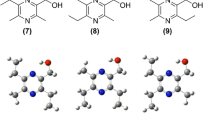Abstract
The flower of a sexually deceptive orchid, Chiloglottis reflexa, mimics both the sex pheromone and the appearance of a female thynnine wasp (Neozeloboria nr. proxima). The flower is pollinated when visited by male wasps, who attempt mating with the flower. We have used these mimetic flowers to investigate mating behavior of the male wasps. In field choice experiments, males strongly prefer to visit flowers that are very low in the habitat, 15 cm, vs. flowers that are placed at 55 or 105 cm. These studies suggest that male precopulatory response is strongly dependent on the microlocation of the female (or female mimic). Other insect-mimicking orchids, which together attract several groups of Hymenoptera, may be useful in analogous experiments on mating behavior. Additionally, these experiments help elucidate features of the mimetic flowers, particularly stature, that act to efficiently attract potential pollinators.
Similar content being viewed by others
References
Alcock J (1981) Notes on the reproductive behavior of some Australian thynnine wasps (Hymenoptera: Tiphiidae). J Kansas Entomol Soc 54:681–693
Alcock J (1988) The kookaburras' song. Exploring animal behavior in Australia. Univ Arizona Press, Tucson
Alcock J, Barrows EM, Gordh G, Hubbard LJ, Kirkendall L, Pyle DW, Ponder TL, Zalom FG (1978) The ecology and evolution of male reproductive behaviour in the bees and wasps. Zool J Linn Soc 64:293–326
Alcock J, Gwynne DT (1987) Courtship feeding and mate choice in thynnine wasps (Hymenoptera: Tippiidae). Austr J Zool 35:451–458
Borg-Karlson A-K (1990) Chemical and ethological studies of pollination in the genus Ophrys (Orchidaceae). Phytochem 29:1359–1387
Dafni A (1984) Mimicry and deception in pollination. Ann Rev Ecol System 15:259–278
Dafni A, Bernhardt P (1990) Pollination of terrestrial orchids of southern Australia and the Mediterranean region. Systematic, ecological, and evolutionary implications. Evol Biol 24:193–252
Eickwort GC, Ginsberg HS (1980) Foraging and mating behavior in Apoidea. Ann Rev Entom 25:421–446
Hölldobler B, Wilson EO (1990) The ants Harvard Univ Press, Cambridge, MA, USA
Jones DL (1988) Native Orchids of Australia. Reed Books, Frenchs Forest, New South Wales, Australia
Jones DL (1991) NEw taxa of Australian Orchidaceae. Australian Orchid Foundation, Essendon, Victoria, Australia. Austr Orchid Res 2:1–208
Oakwood M (1990) Population genetics and pollination ecology of Chiloglottis trapeziformis Fitzg. (Orchidaceae). Honours thesis, School of Biological Sciences, Macquarie University, Sydney, Australia
Paulus HF, Gack C (1980) Beobachtungen und Untersuchungen zur Bestäubungsbiologie südspanischer Ophrys-Arten. Jahresber Naturwiss Verein Wuppertal, [Suppl] 33:55–68
Peakall R (1989) The unique pollination of Leporella fimbriata (Orchidaceae): pollination by pseudocopulating male ants (Myrmecia urens, Formicidae). Plant Syst Evol 167:137–148
Peakall R (1990) Responses of male Zaspilothynnus trilobatus Turner wasps to females and the sexually deceptive orchid it pollinates. Funct Ecol 4:159–167
Peakall R, Handel SN (1993) Pollinators discriminate among floral heights of a sexually deceptive orchid: implications for selection. Evolution (in press)
Ridsdill Smith TJ (1970) The behaviour of Hemithynnus hyalinatus (Hymenoptera: Tiphiidae), with notes on some other Thynninae. J Austr Entomol Soc 9:196–208
Stadler E (1992) Behavioral responses of insects to plant secondary compounds. In: Rosenthal GA, Berenbaum MR (eds) Herbivores, their interactions with secondary plant metabolites. 2nd ed., Vol. II: Ecological and evolutionary processes Academic Press, San Diego, pp 45–88
Stoutamire WP (1974) Australian terrestrial orchids, thynnid wasps and pseudocopulation. Am Orchid Soc Bull 43:13–18
Stoutamire WP (1975) Pseudocopulation in Australian terrestrial orchids. Am Orchid Soc Bull 44:226–233
Stoutamire WP (1983) Wasp-pollinated species of Caladenia in South-western Australia. Austr J Bot 31:383–394
Woolcock CE, Woolcock DT (1984) Australian terrestrial orchids. Nelson, Melbourne, Australia
Author information
Authors and Affiliations
Rights and permissions
About this article
Cite this article
Handel, S.N., Peakall, R. Thynnine wasps discriminate among heights when seeking mates: tests with a sexually deceptive orchid. Oecologia 95, 241–245 (1993). https://doi.org/10.1007/BF00323496
Received:
Accepted:
Issue Date:
DOI: https://doi.org/10.1007/BF00323496




